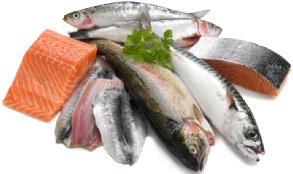Fish is Important to a Healthy Diet
TEXARKANA, Ark. –
As a child, we had fish at least once with each visit at my grandmother’s home. She loved to fish and took me every chance she had to catch that night’s dinner. There is definitely a taste difference with fresh caught over store bought. Now that my grandmother is no longer with me, I luckily still have those memories.
Little did I know at the time that fish and other seafood are a part of a healthy diet. Fish is rich in key nutrients, including vitamins A, B12, and D as well as iron, zinc, magnesium, phosphorous and potassium. It is low in saturated fat, which contributes to high blood cholesterol levels. It is high in a healthier form of fat: omega-3 fatty acids. Research has shown that omega-3 fatty acids help make blood less “sticky” and therefore is less likely to form clots that can contribute to heart disease. Fatty fish such as salmon, tuna, trout, sardines and halibut have the highest amounts of omega-3 fatty acids.
The 2015-20 Dietary Guidelines for Americans recommends that Americans eat at least two servings of seafood per week as part of a healthy diet. For an average 2,000-calorie-per-day diet, that translates into at least 8 ounces of fish and shellfish per week. As a point of reference, 4 ounces cooked fish is about the size of a deck of cards and is equal to a serving.
If you are not accustomed to eating fish regularly, here are some ideas to help you include more fish:
• Start slow by including fish in at least one meal a week.
• Canned fish and frozen fish are great options. Just make sure the canned fish is packed in water, not oils.
• Add fish and seafood to recipes that normally call for beef or chicken.
• Try different fish to find the ones you like. Fish is relatively inexpensive when purchased at the meat counter in the supermarket.
• Choose fish more often for lunch and dinner. Try salmon steak or filet, salmon loaf, or baked or grilled trout, grilled tilapia or baked catfish.
It may be that when you think about eating fish, you are thinking about heavily breaded, deep fried fish. For many this is the most common way of preparing and eating fish. However, this is not the healthiest option.
There are healthier and easier ways of preparing fish, including baking, grilling pan-frying or microwaving. Fish is a good food to cook in the microwave oven. It cooks quickly and is naturally tender. Just be sure to allow standing time.
Another option to consider is adding canned fish like salmon and tuna to salads and casseroles. Many have a favorite tuna casserole recipe, but even healthier and easier is to add the canned tuna to a lettuce salad. This is a quick, easy to prepare meal.
Another quick and easy meal is Ole` Baked Fish. You can have this on the table in as little as 30 minutes. You can also modify the recipe and use boneless, skinless chicken breast in place of the fish for a two for one recipe.
Ole` Baked Fish
1 1/2 pounds firm fish, such as catfish, tilapia or cod
1 cup salsa (mild for a light taste, hot if you like it hot)
1 cup shredded pepper jack and cheddar cheese
1/2 cup crushed corn chips
1 avocado - peeled, pitted and sliced
1/4 cup lite sour cream
Preheat oven to 400 degrees. Lightly spray an 8 x 12 inch baking dish with non-stick cooking spray. Rinse fillets under cold water and pat dry with paper towels. Place fillets side by side in baking dish. Pour the salsa over the top and sprinkle with the shredded cheese evenly. Top with evenly placed, crushed corn chips. Bake, uncovered, in a preheated oven for 15 minutes, or until fish is opaque and flakes with a fork. Serve topped with sliced avocado and sour cream. To complete the meal, serve on a bed of rice with black beans, tossed green salad and warm whole-wheat tortillas for a fast, healthy meal.
Note: For a crunchy topping, place dish under the oven broiler for a minute or two until lightly browned.
For more information, contact the Miller County Extension Office, 870-779-3609 or visit us in room 215 at the Miller County Courthouse. We're online at cdue@uada.edu, on Facebook at UAEXMillerCountyFCS/CarlaDue, on Twitter @MillerCountyFCS or on the web at uaex.uada.edu/Miller.
By Carla Due
County Extension Agent - FCS
The Cooperative Extension Service
U of A System Division of Agriculture
Media Contact: Carla Due
County Extension Agent - FCS
U of A Division of Agriculture
Cooperative Extension Service
400 Laurel Street, Suite 215 Texarkana AR 71854
(870) 779-3609
cdue@uada.edu
The Arkansas Cooperative Extension Service is an equal opportunity institution. If
you require a reasonable accommodation to participate or need materials in another
format, please contact your County Extension office (or other appropriate office)
as soon as possible. Dial 711 for Arkansas Relay.
Pursuant to 7 CFR § 15.3, the University of Arkansas System Division of Agriculture
offers all its Extension and Research programs and services (including employment)
without regard to race, color, sex, national origin, religion, age, disability, marital
or veteran status, genetic information, sexual preference, pregnancy or any other
legally protected status, and is an equal opportunity institution.
